Cancer Education Slides Brain Tumor 2009 What is

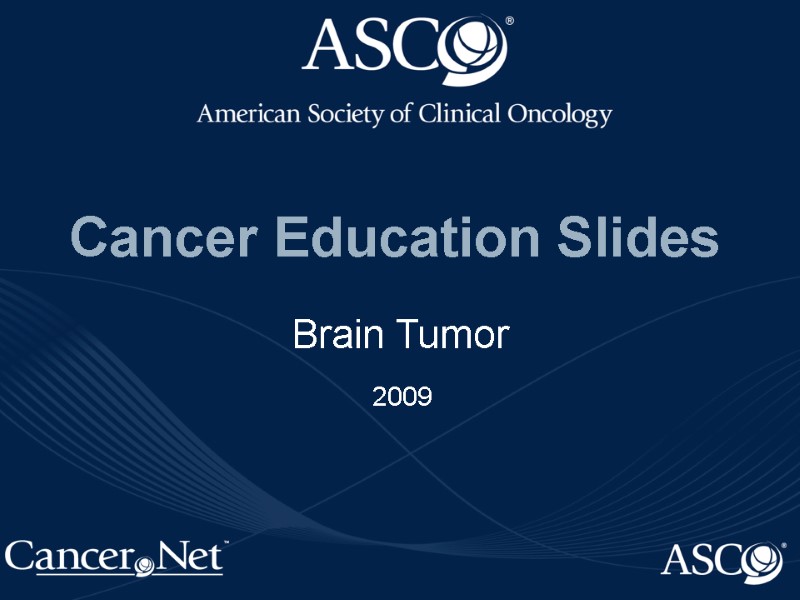
Cancer Education Slides Brain Tumor 2009
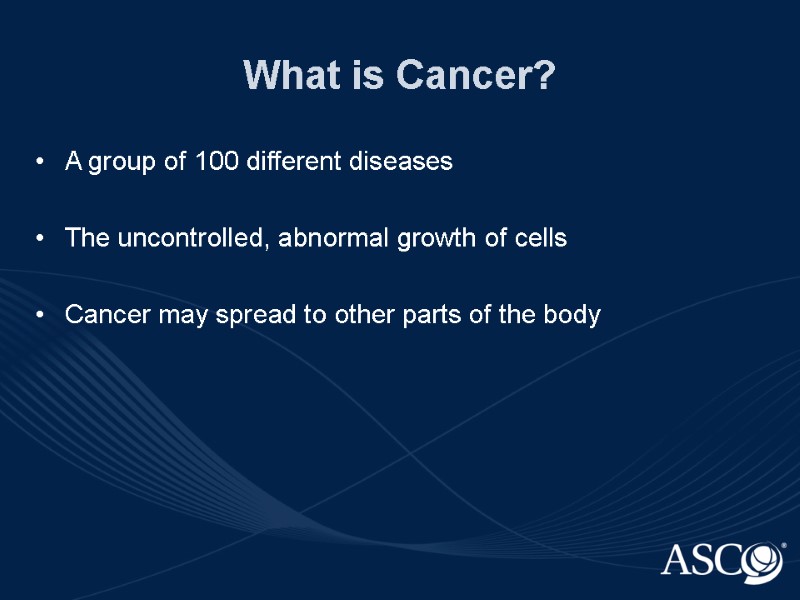
What is Cancer? A group of 100 different diseases The uncontrolled, abnormal growth of cells Cancer may spread to other parts of the body
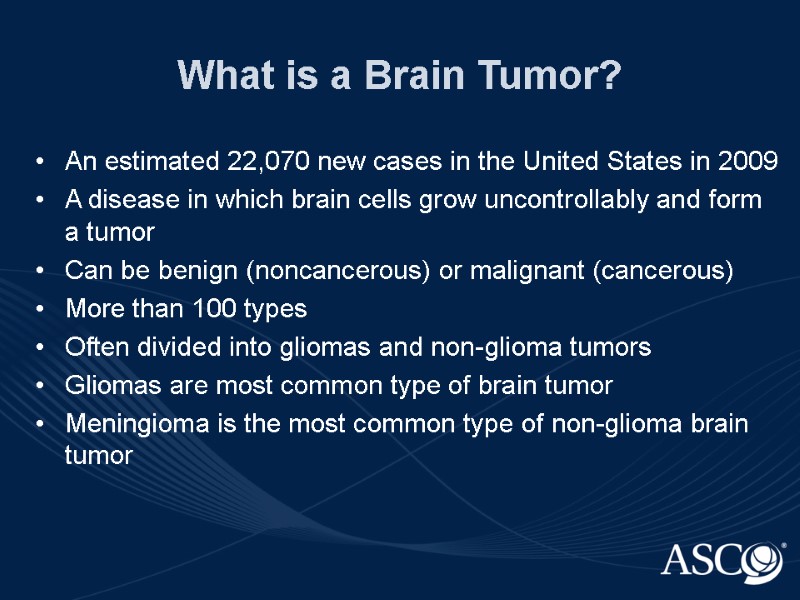
What is a Brain Tumor? An estimated 22,070 new cases in the United States in 2009 A disease in which brain cells grow uncontrollably and form a tumor Can be benign (noncancerous) or malignant (cancerous) More than 100 types Often divided into gliomas and non-glioma tumors Gliomas are most common type of brain tumor Meningioma is the most common type of non-glioma brain tumor
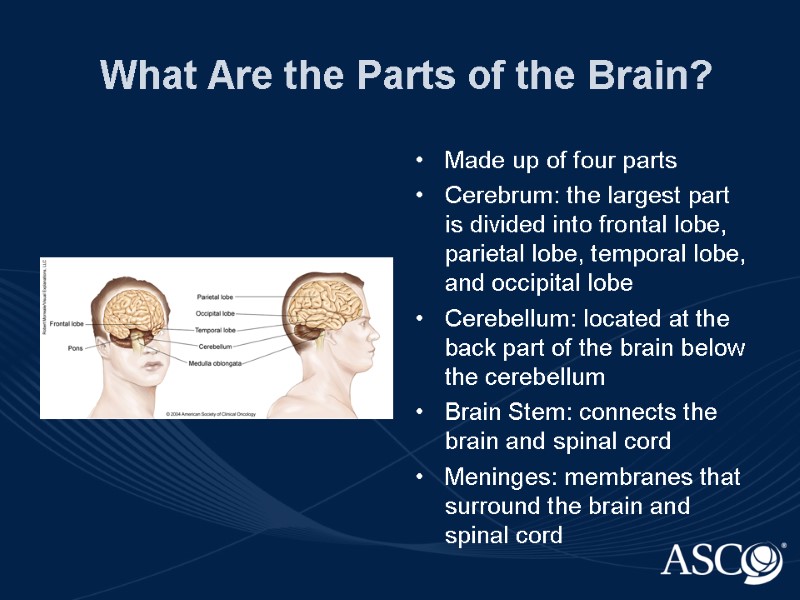
What Are the Parts of the Brain? Made up of four parts Cerebrum: the largest part is divided into frontal lobe, parietal lobe, temporal lobe, and occipital lobe Cerebellum: located at the back part of the brain below the cerebellum Brain Stem: connects the brain and spinal cord Meninges: membranes that surround the brain and spinal cord
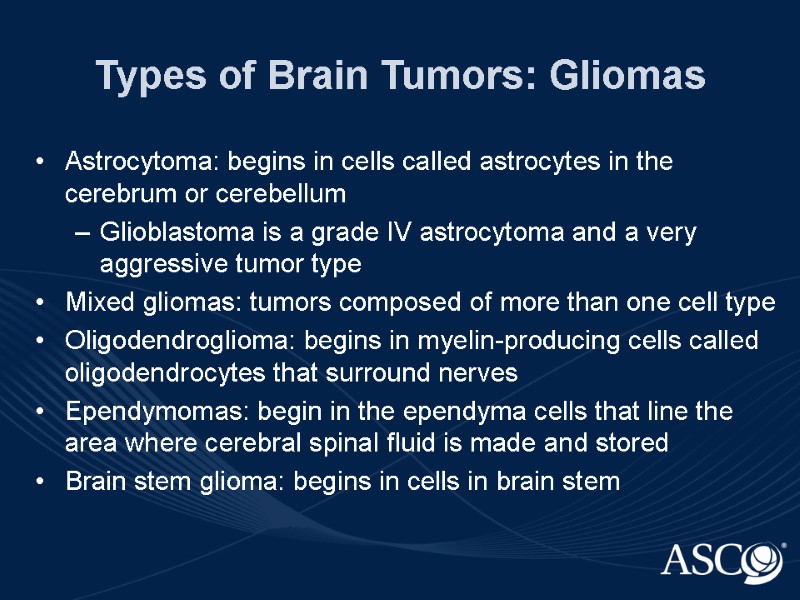
Types of Brain Tumors: Gliomas Astrocytoma: begins in cells called astrocytes in the cerebrum or cerebellum Glioblastoma is a grade IV astrocytoma and a very aggressive tumor type Mixed gliomas: tumors composed of more than one cell type Oligodendroglioma: begins in myelin-producing cells called oligodendrocytes that surround nerves Ependymomas: begin in the ependyma cells that line the area where cerebral spinal fluid is made and stored Brain stem glioma: begins in cells in brain stem
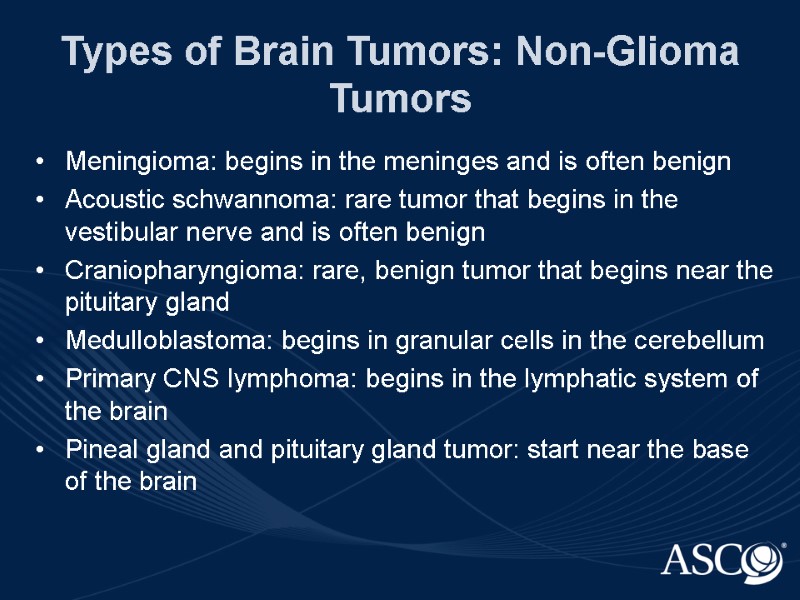
Types of Brain Tumors: Non-Glioma Tumors Meningioma: begins in the meninges and is often benign Acoustic schwannoma: rare tumor that begins in the vestibular nerve and is often benign Craniopharyngioma: rare, benign tumor that begins near the pituitary gland Medulloblastoma: begins in granular cells in the cerebellum Primary CNS lymphoma: begins in the lymphatic system of the brain Pineal gland and pituitary gland tumor: start near the base of the brain
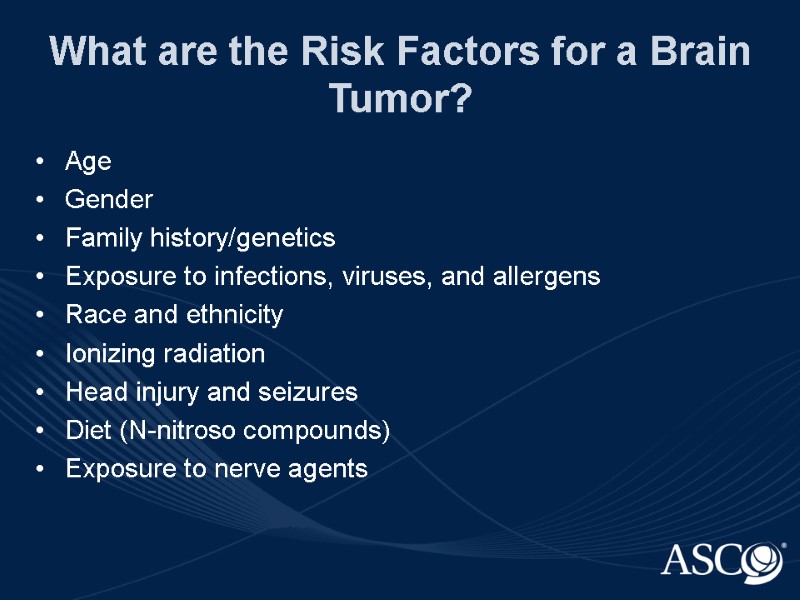
What are the Risk Factors for a Brain Tumor? Age Gender Family history/genetics Exposure to infections, viruses, and allergens Race and ethnicity Ionizing radiation Head injury and seizures Diet (N-nitroso compounds) Exposure to nerve agents
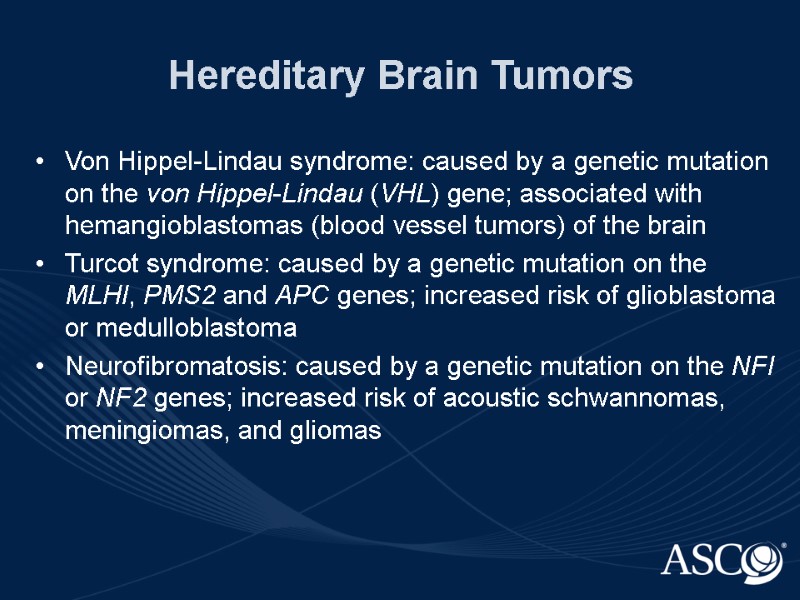
Hereditary Brain Tumors Von Hippel-Lindau syndrome: caused by a genetic mutation on the von Hippel-Lindau (VHL) gene; associated with hemangioblastomas (blood vessel tumors) of the brain Turcot syndrome: caused by a genetic mutation on the MLHI, PMS2 and APC genes; increased risk of glioblastoma or medulloblastoma Neurofibromatosis: caused by a genetic mutation on the NFI or NF2 genes; increased risk of acoustic schwannomas, meningiomas, and gliomas
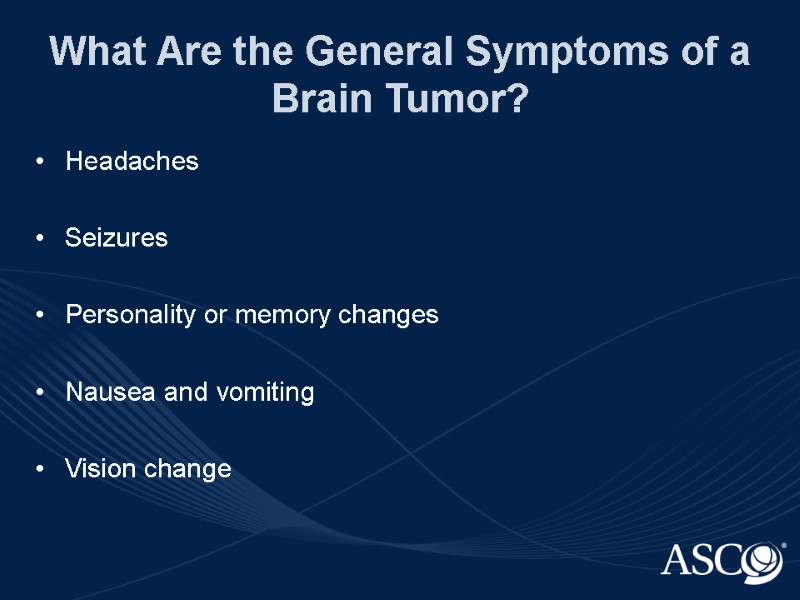
What Are the General Symptoms of a Brain Tumor? Headaches Seizures Personality or memory changes Nausea and vomiting Vision change
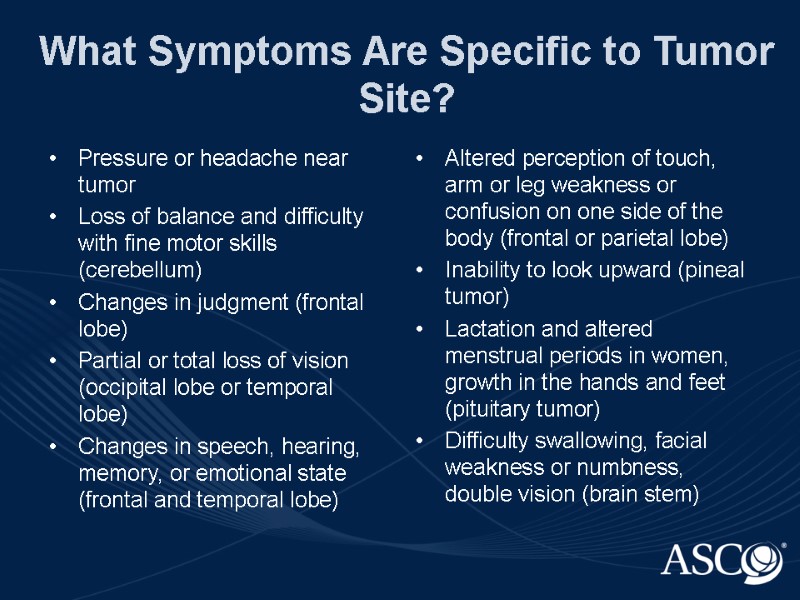
What Symptoms Are Specific to Tumor Site? Pressure or headache near tumor Loss of balance and difficulty with fine motor skills (cerebellum) Changes in judgment (frontal lobe) Partial or total loss of vision (occipital lobe or temporal lobe) Changes in speech, hearing, memory, or emotional state (frontal and temporal lobe) Altered perception of touch, arm or leg weakness or confusion on one side of the body (frontal or parietal lobe) Inability to look upward (pineal tumor) Lactation and altered menstrual periods in women, growth in the hands and feet (pituitary tumor) Difficulty swallowing, facial weakness or numbness, double vision (brain stem)
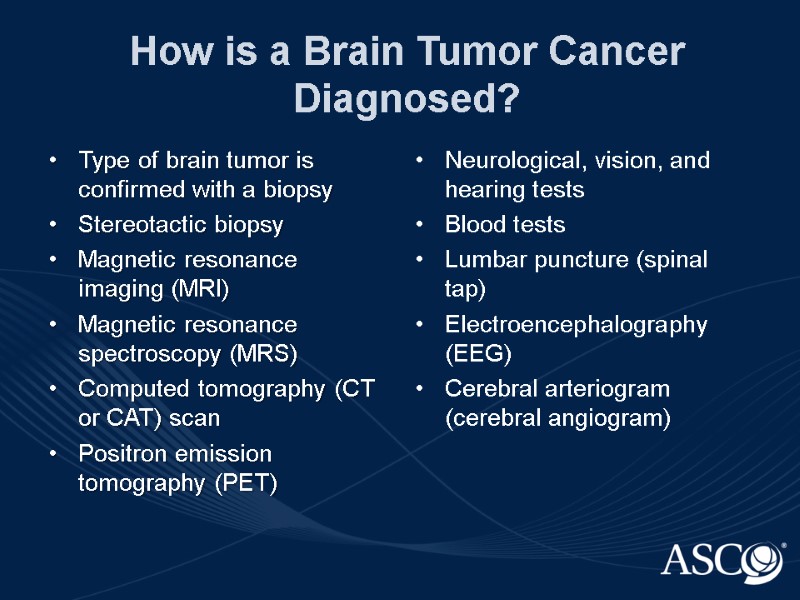
How is a Brain Tumor Cancer Diagnosed? Type of brain tumor is confirmed with a biopsy Stereotactic biopsy Magnetic resonance imaging (MRI) Magnetic resonance spectroscopy (MRS) Computed tomography (CT or CAT) scan Positron emission tomography (PET) Neurological, vision, and hearing tests Blood tests Lumbar puncture (spinal tap) Electroencephalography (EEG) Cerebral arteriogram (cerebral angiogram)
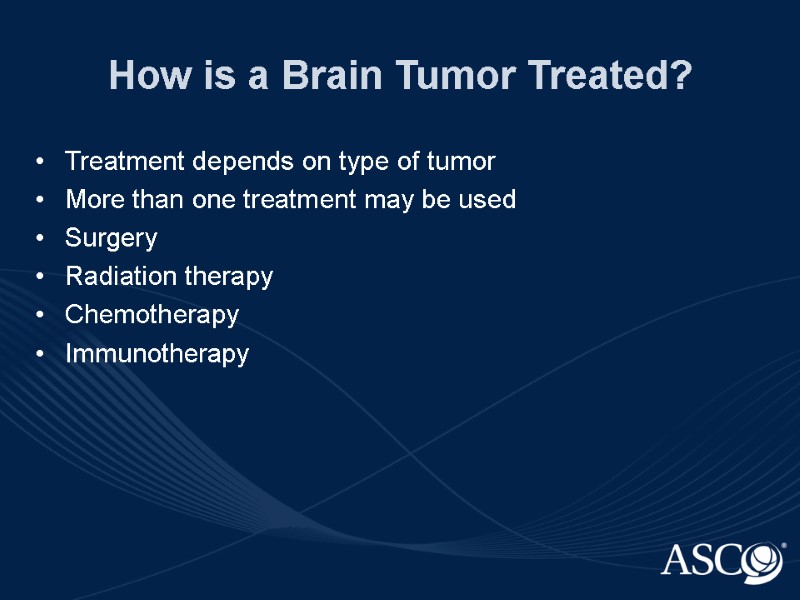
How is a Brain Tumor Treated? Treatment depends on type of tumor More than one treatment may be used Surgery Radiation therapy Chemotherapy Immunotherapy
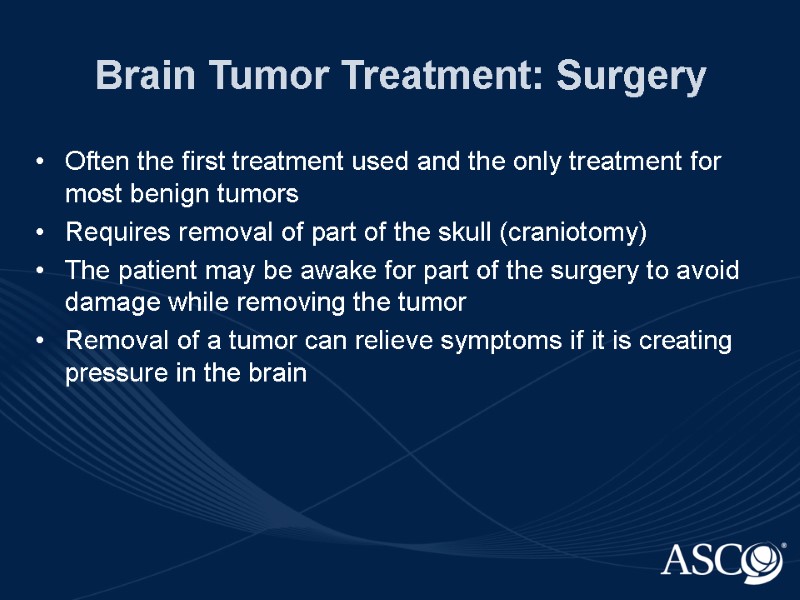
Brain Tumor Treatment: Surgery Often the first treatment used and the only treatment for most benign tumors Requires removal of part of the skull (craniotomy) The patient may be awake for part of the surgery to avoid damage while removing the tumor Removal of a tumor can relieve symptoms if it is creating pressure in the brain
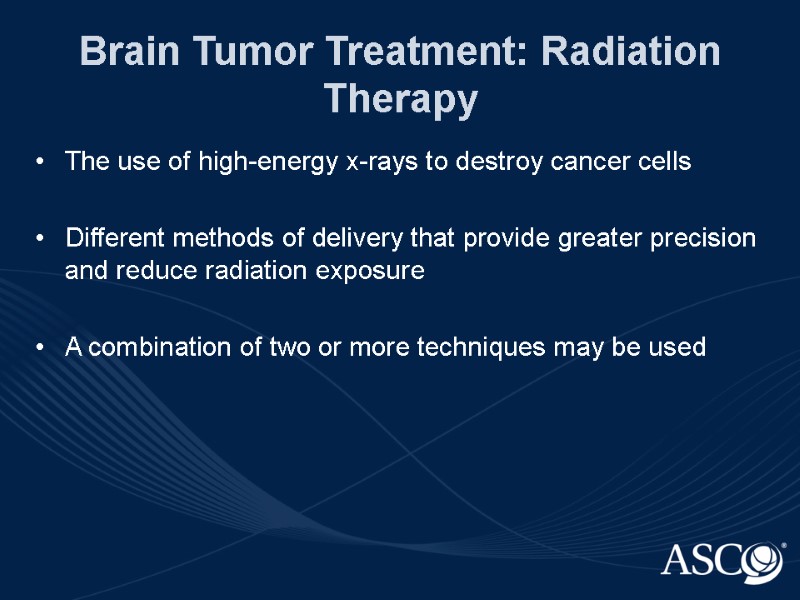
Brain Tumor Treatment: Radiation Therapy The use of high-energy x-rays to destroy cancer cells Different methods of delivery that provide greater precision and reduce radiation exposure A combination of two or more techniques may be used
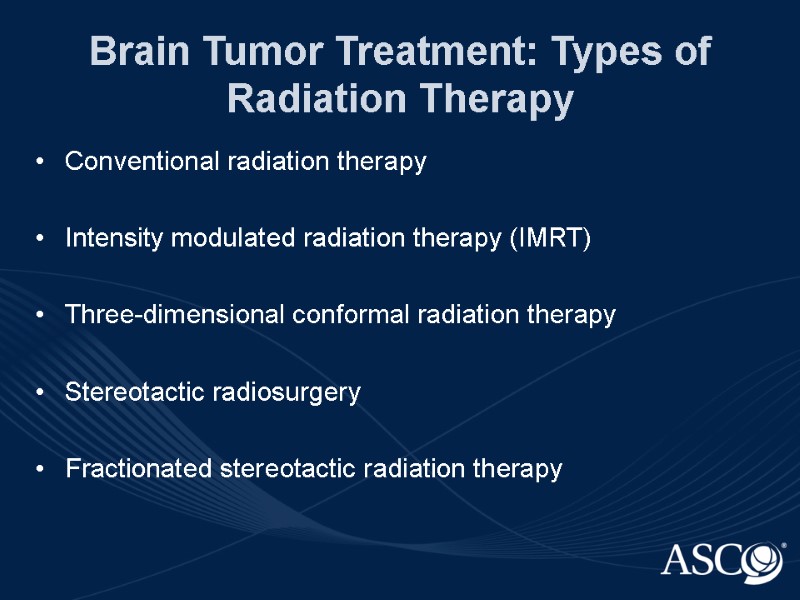
Brain Tumor Treatment: Types of Radiation Therapy Conventional radiation therapy Intensity modulated radiation therapy (IMRT) Three-dimensional conformal radiation therapy Stereotactic radiosurgery Fractionated stereotactic radiation therapy
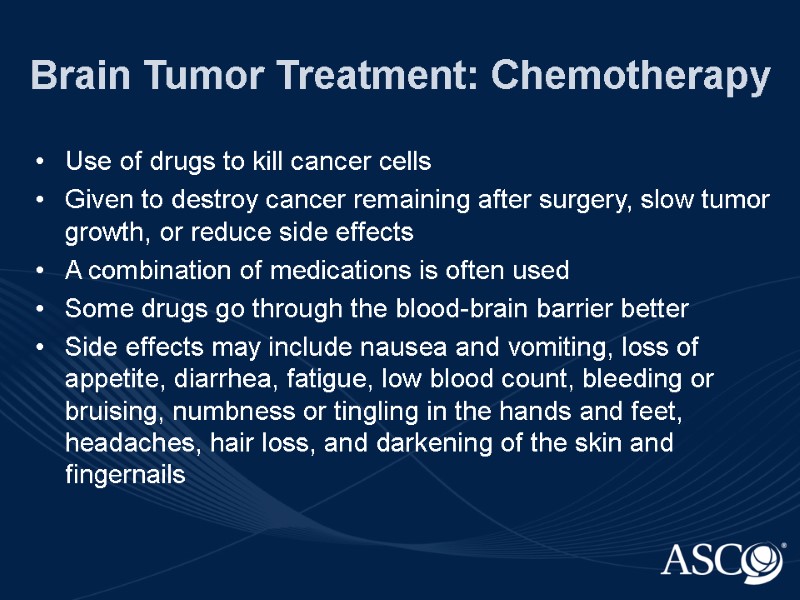
Brain Tumor Treatment: Chemotherapy Use of drugs to kill cancer cells Given to destroy cancer remaining after surgery, slow tumor growth, or reduce side effects A combination of medications is often used Some drugs go through the blood-brain barrier better Side effects may include nausea and vomiting, loss of appetite, diarrhea, fatigue, low blood count, bleeding or bruising, numbness or tingling in the hands and feet, headaches, hair loss, and darkening of the skin and fingernails
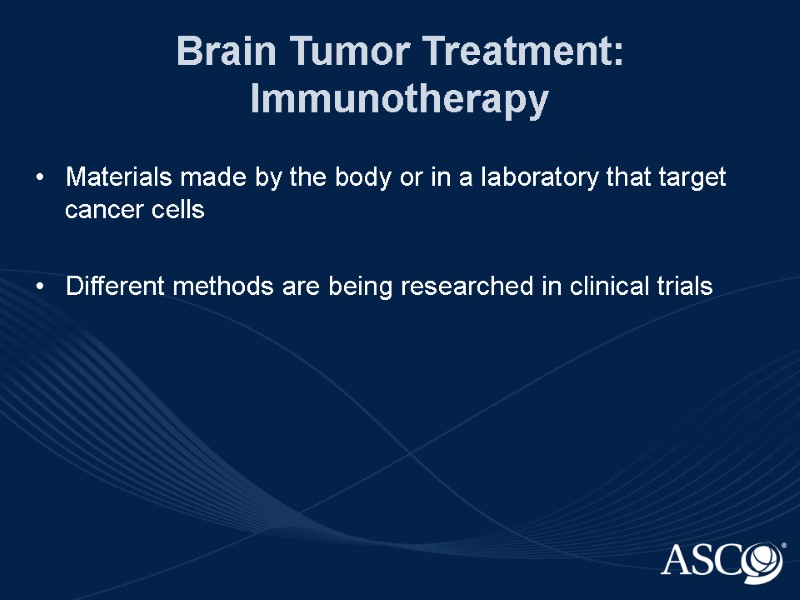
Brain Tumor Treatment: Immunotherapy Materials made by the body or in a laboratory that target cancer cells Different methods are being researched in clinical trials
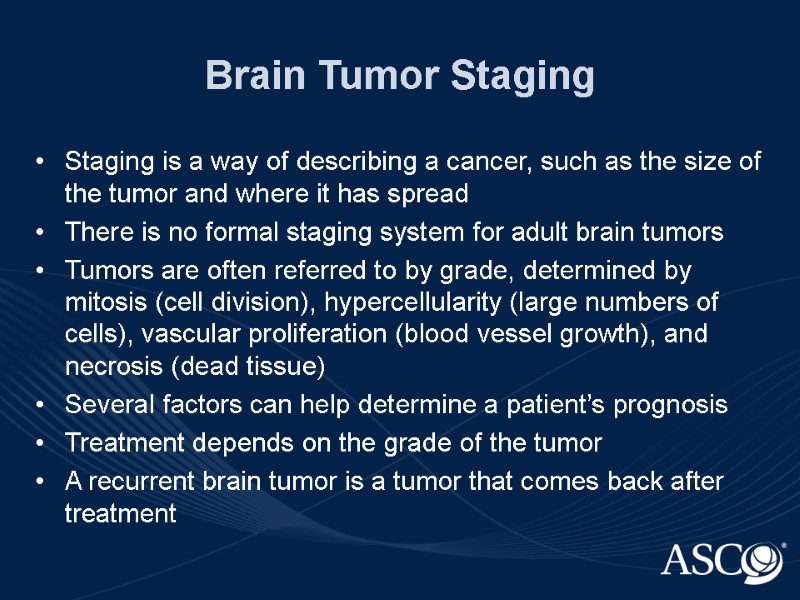
Brain Tumor Staging Staging is a way of describing a cancer, such as the size of the tumor and where it has spread There is no formal staging system for adult brain tumors Tumors are often referred to by grade, determined by mitosis (cell division), hypercellularity (large numbers of cells), vascular proliferation (blood vessel growth), and necrosis (dead tissue) Several factors can help determine a patient’s prognosis Treatment depends on the grade of the tumor A recurrent brain tumor is a tumor that comes back after treatment
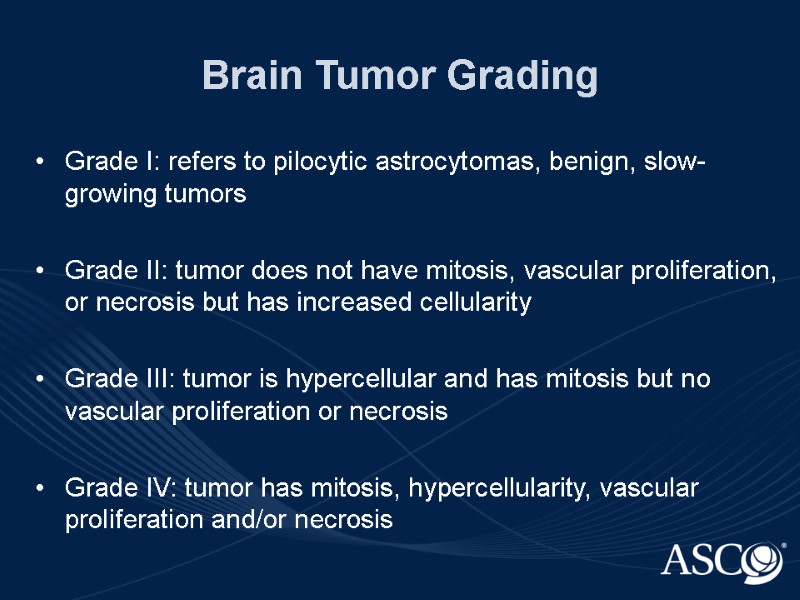
Brain Tumor Grading Grade I: refers to pilocytic astrocytomas, benign, slow-growing tumors Grade II: tumor does not have mitosis, vascular proliferation, or necrosis but has increased cellularity Grade III: tumor is hypercellular and has mitosis but no vascular proliferation or necrosis Grade IV: tumor has mitosis, hypercellularity, vascular proliferation and/or necrosis
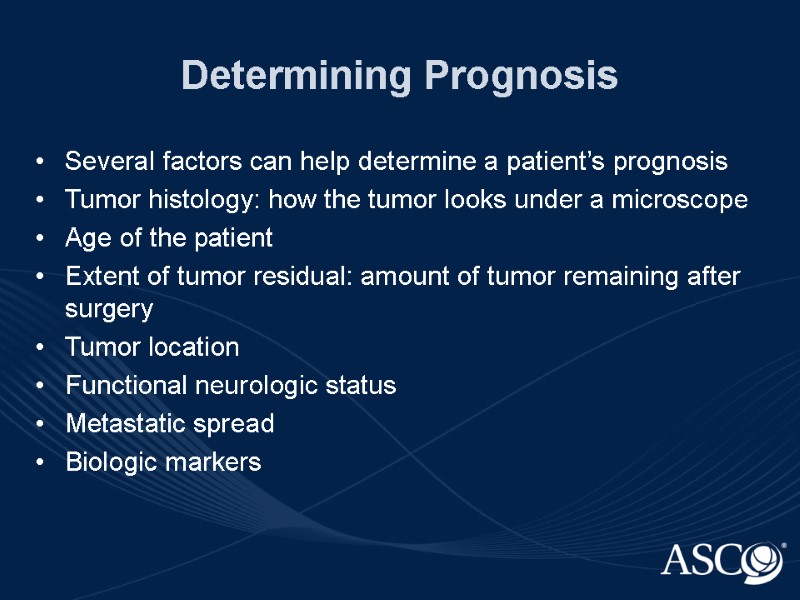
Determining Prognosis Several factors can help determine a patient’s prognosis Tumor histology: how the tumor looks under a microscope Age of the patient Extent of tumor residual: amount of tumor remaining after surgery Tumor location Functional neurologic status Metastatic spread Biologic markers
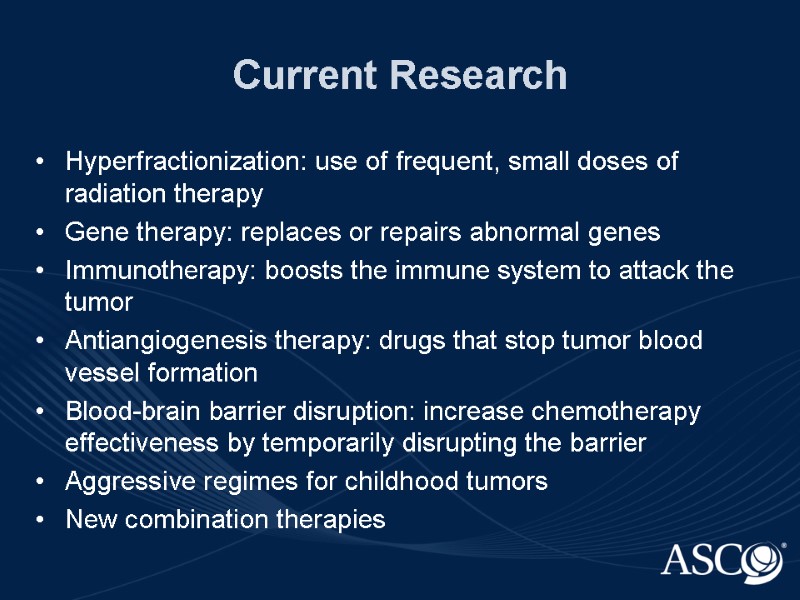
Current Research Hyperfractionization: use of frequent, small doses of radiation therapy Gene therapy: replaces or repairs abnormal genes Immunotherapy: boosts the immune system to attack the tumor Antiangiogenesis therapy: drugs that stop tumor blood vessel formation Blood-brain barrier disruption: increase chemotherapy effectiveness by temporarily disrupting the barrier Aggressive regimes for childhood tumors New combination therapies
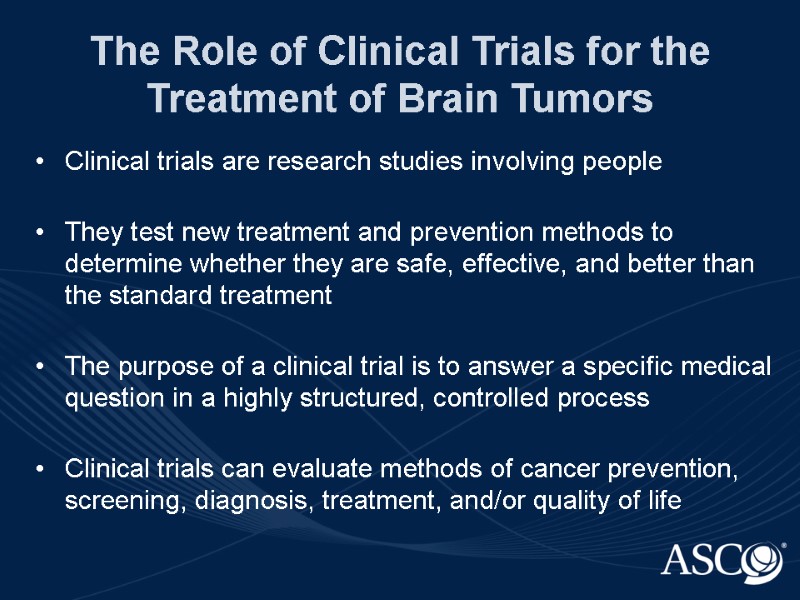
The Role of Clinical Trials for the Treatment of Brain Tumors Clinical trials are research studies involving people They test new treatment and prevention methods to determine whether they are safe, effective, and better than the standard treatment The purpose of a clinical trial is to answer a specific medical question in a highly structured, controlled process Clinical trials can evaluate methods of cancer prevention, screening, diagnosis, treatment, and/or quality of life
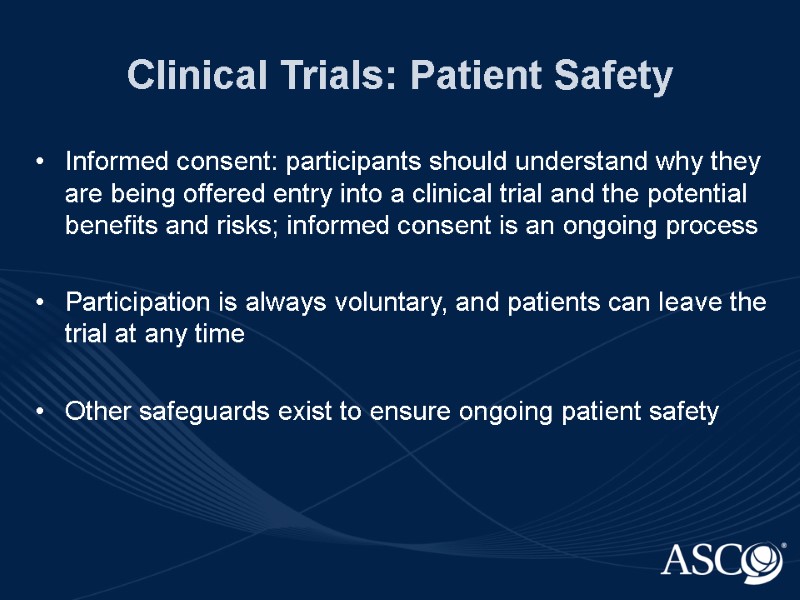
Clinical Trials: Patient Safety Informed consent: participants should understand why they are being offered entry into a clinical trial and the potential benefits and risks; informed consent is an ongoing process Participation is always voluntary, and patients can leave the trial at any time Other safeguards exist to ensure ongoing patient safety
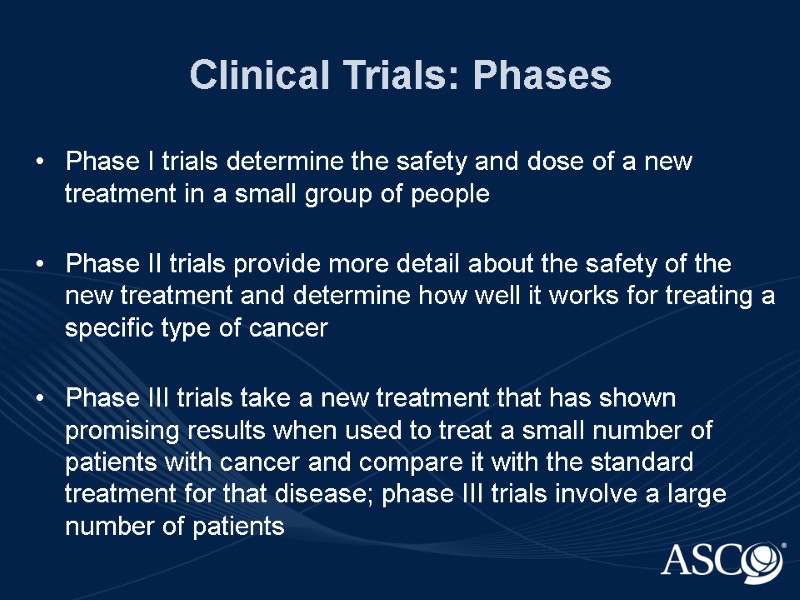
Clinical Trials: Phases Phase I trials determine the safety and dose of a new treatment in a small group of people Phase II trials provide more detail about the safety of the new treatment and determine how well it works for treating a specific type of cancer Phase III trials take a new treatment that has shown promising results when used to treat a small number of patients with cancer and compare it with the standard treatment for that disease; phase III trials involve a large number of patients
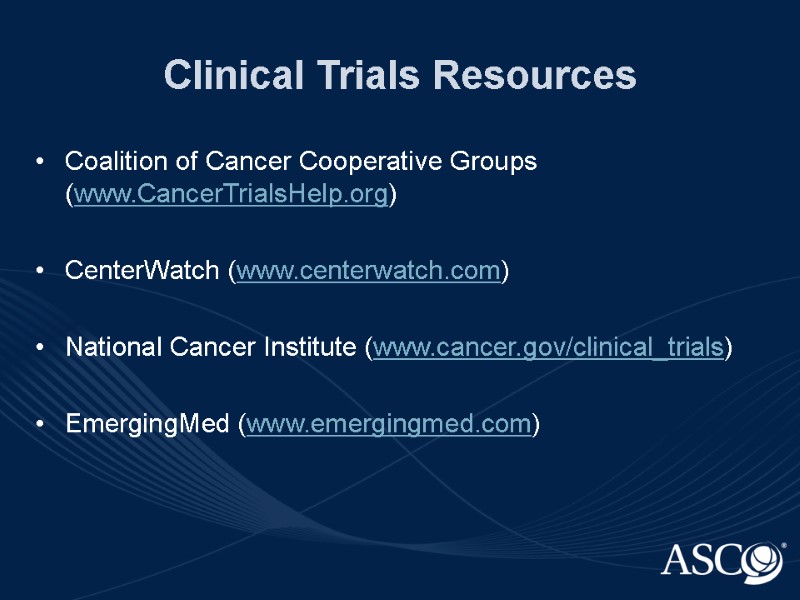
Clinical Trials Resources Coalition of Cancer Cooperative Groups (www.CancerTrialsHelp.org) CenterWatch (www.centerwatch.com) National Cancer Institute (www.cancer.gov/clinical_trials) EmergingMed (www.emergingmed.com)
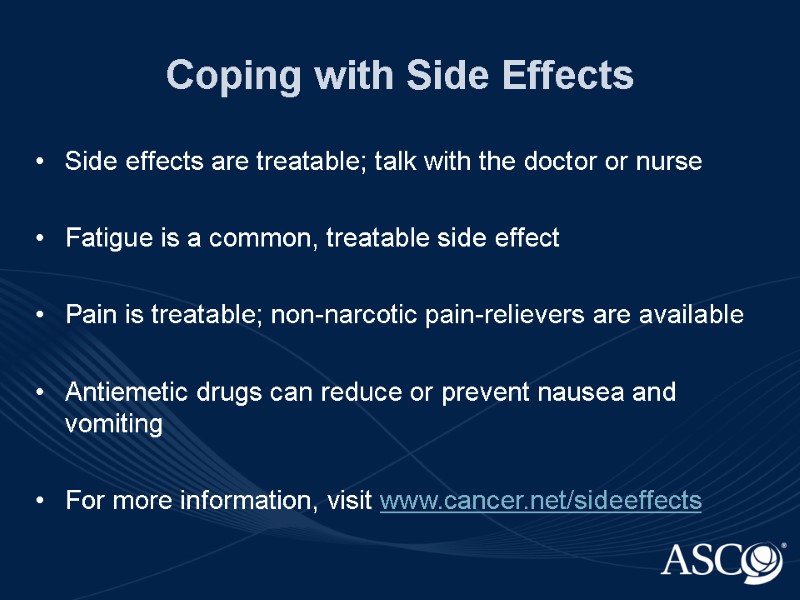
Coping with Side Effects Side effects are treatable; talk with the doctor or nurse Fatigue is a common, treatable side effect Pain is treatable; non-narcotic pain-relievers are available Antiemetic drugs can reduce or prevent nausea and vomiting For more information, visit www.cancer.net/sideeffects
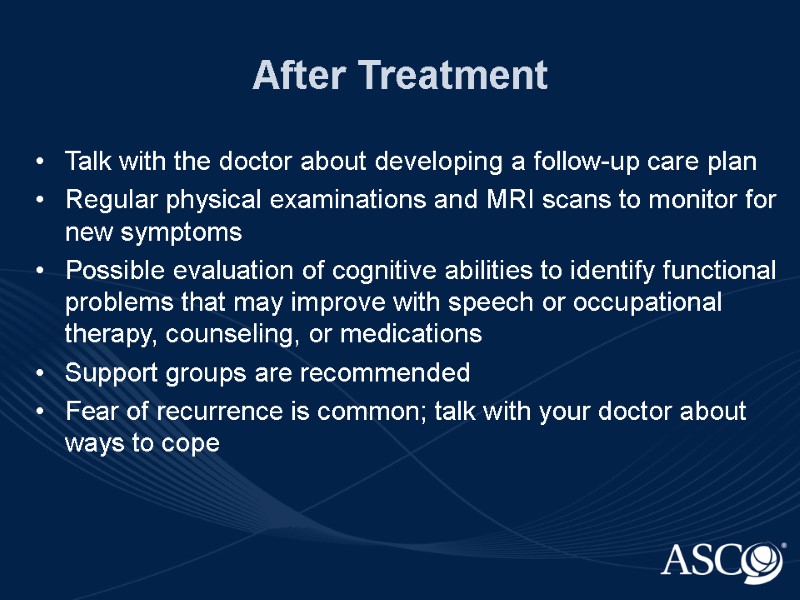
After Treatment Talk with the doctor about developing a follow-up care plan Regular physical examinations and MRI scans to monitor for new symptoms Possible evaluation of cognitive abilities to identify functional problems that may improve with speech or occupational therapy, counseling, or medications Support groups are recommended Fear of recurrence is common; talk with your doctor about ways to cope
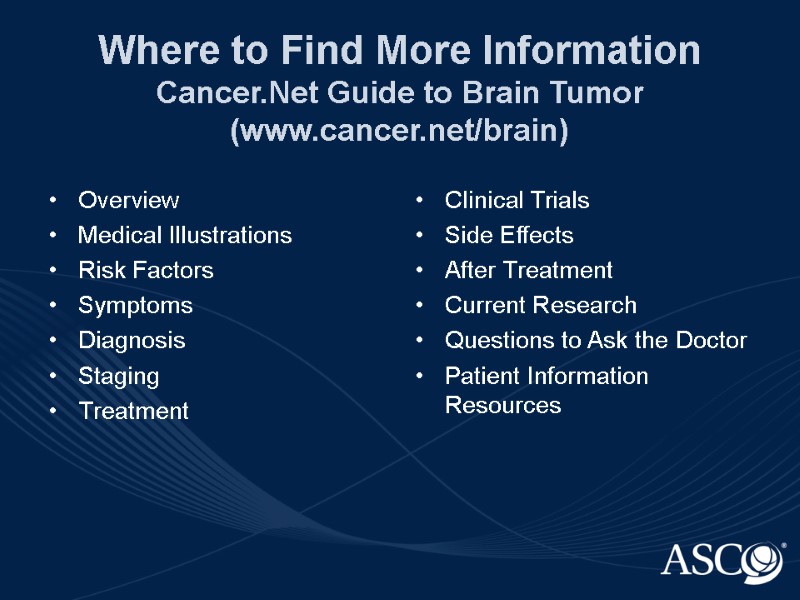
Where to Find More Information Cancer.Net Guide to Brain Tumor (www.cancer.net/brain) Overview Medical Illustrations Risk Factors Symptoms Diagnosis Staging Treatment Clinical Trials Side Effects After Treatment Current Research Questions to Ask the Doctor Patient Information Resources
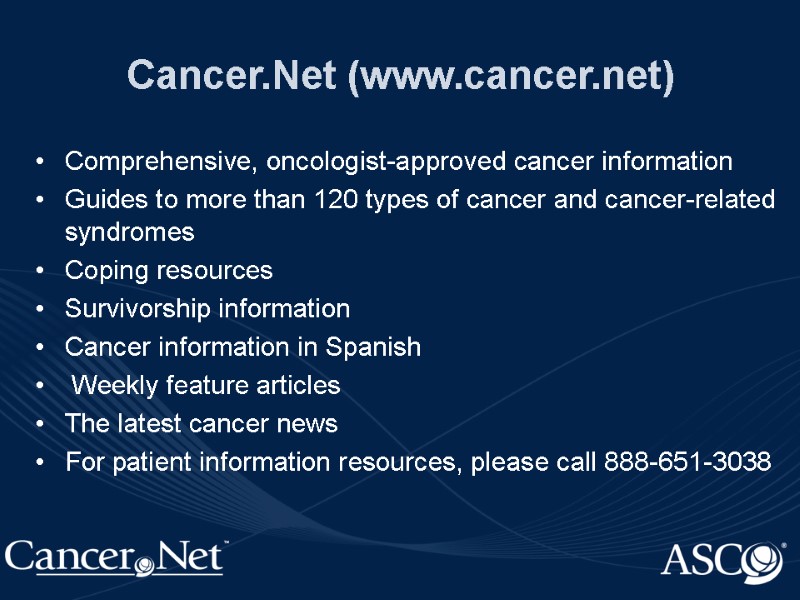
Cancer.Net (www.cancer.net) Comprehensive, oncologist-approved cancer information Guides to more than 120 types of cancer and cancer-related syndromes Coping resources Survivorship information Cancer information in Spanish Weekly feature articles The latest cancer news For patient information resources, please call 888-651-3038
15472-brain_tumor_.ppt
- Количество слайдов: 29

